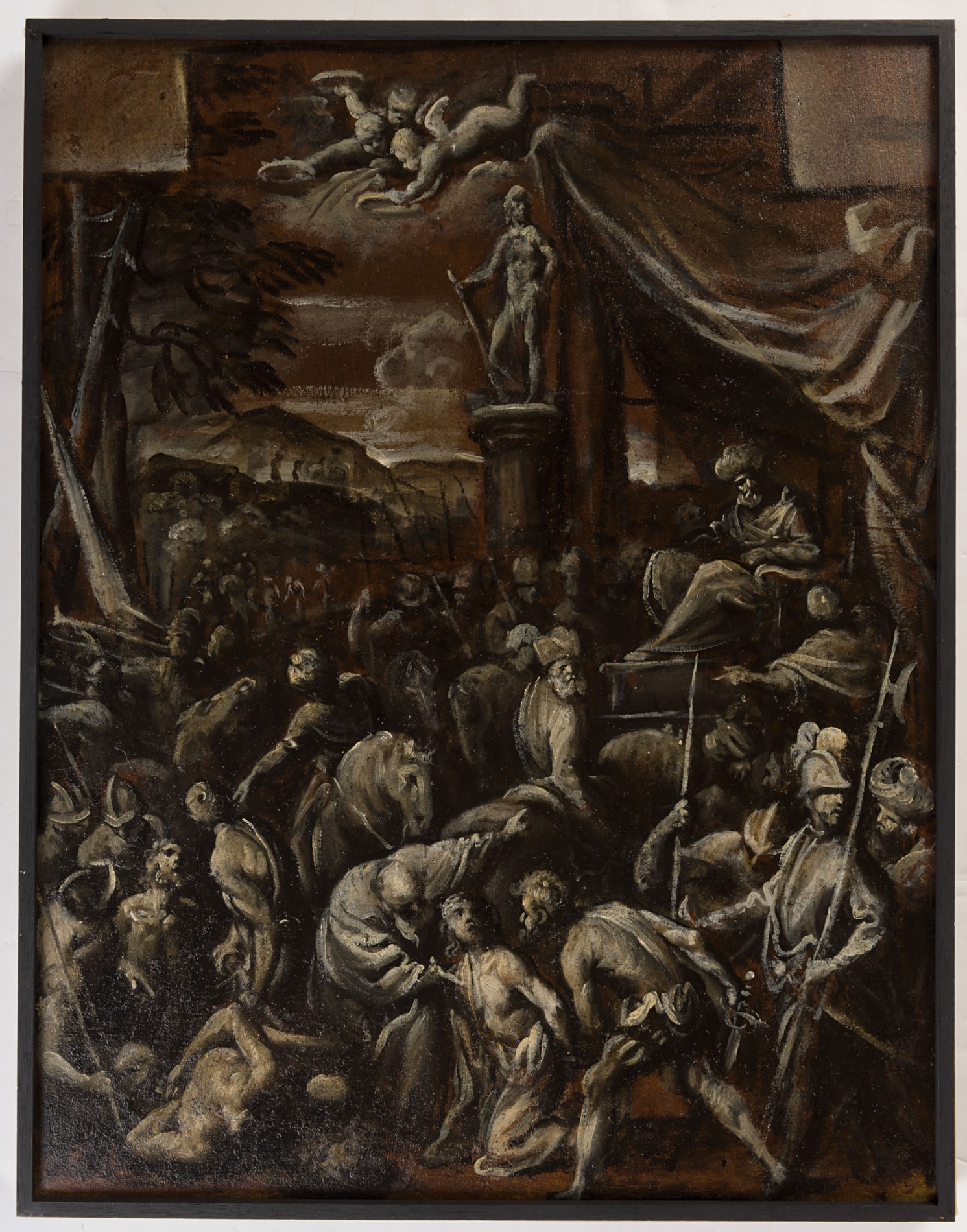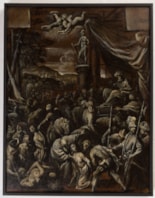Pietro SORRI
(San Gusmè 1556 - Siena 1622)
The Martyrdom of Saints Valerian, Tiburtius and Maximus
Sold
Monochrome oil paint heightened with white on paper washed grey, laid down on canvas.
A study of a male nude in black chalk on the verso, now laid down.
The paper torn in several places and repaired.
Inscribed il Tintoretto on the former mount.
448 x 349 mm. (17 5/8 x 13 3/4 in.) [sheet]
A study of a male nude in black chalk on the verso, now laid down.
The paper torn in several places and repaired.
Inscribed il Tintoretto on the former mount.
448 x 349 mm. (17 5/8 x 13 3/4 in.) [sheet]
Traditionally attributed to Tintoretto, this oil sketch is stylistically comparable to other bozzetti by Pietro Sorri, and in particular to an Adoration of the Magi in the Biblioteca Marucelliana in Florence. Both works are similar in composition and technique, and the figure of a man drawing his sword at the lower left of the present drawing reoccurs in the same pose but holding a dog on a leash in the Florentine sheet. The Marucelliana sketch is an early preparatory study for a painting of The Adoration of the Magi in the Duomo in Siena, completed by Sorri in 1588, shortly after his return from Venice. As Laura Martini has noted, both the painting and the Marucelliana bozzetto display the influence of Sorri’s Venetian contemporaries, and the same is true of the present sheet.
The attribution to Sorri of the Marucelliana oil sketch is not, however, unanimously accepted, and it was published with an attribution to Passignano in 1978. In 1990, Giulia Brunetti further noted that the relationship between the Marucelliana oil sketch and the altarpiece in Siena is rather loose, and she therefore adopted a more cautious attitude, preferring to catalogue the former as by ‘Pietro Sorri or Domenico Passignano’.
The present sheet is, however, also closely comparable in both handling and technique to another oil sketch - a Madonna of the Girdle in the Uffizi - which is unanimously accepted as a work by Pietro Sorri, dating from his stay in Venice. The Uffizi bozzetto is a study for a lost painting of 1587-1588 by Sorri, which was once in the church of Sant’Agostino in Siena. Also similar in handling and technique is an oil sketch bozzetto of Christ Among the Doctors in the collection of the Monte de Paschi di Siena, which is a study for an altarpiece by Sorri in the Duomo in Pisa. Furthermore, the black chalk study of a male nude visible on the verso of the present sheet, which has been laid down, appears to be stylistically closer to the draughtsmanship of Sorri than that of Passignano. Consequently, and in view of the lack of evidence to substantiate an alternative attribution to Passignano, an attribution to Pietro Sorri has been retained for this oil sketch, which must likewise be datable to the 1580s.
This oil sketch also appears to be related to a later painting of The Martyrdom of Three Saints in the church of San Pietro in Modena. The present sheet shares many of the same compositional elements, as well as the shape, of the painting in Modena, which has been dated to the 1620s and was formerly attributed to the 17th century Modenese painter Ludovico Lana (1597-1640).
The attribution to Sorri of the Marucelliana oil sketch is not, however, unanimously accepted, and it was published with an attribution to Passignano in 1978. In 1990, Giulia Brunetti further noted that the relationship between the Marucelliana oil sketch and the altarpiece in Siena is rather loose, and she therefore adopted a more cautious attitude, preferring to catalogue the former as by ‘Pietro Sorri or Domenico Passignano’.
The present sheet is, however, also closely comparable in both handling and technique to another oil sketch - a Madonna of the Girdle in the Uffizi - which is unanimously accepted as a work by Pietro Sorri, dating from his stay in Venice. The Uffizi bozzetto is a study for a lost painting of 1587-1588 by Sorri, which was once in the church of Sant’Agostino in Siena. Also similar in handling and technique is an oil sketch bozzetto of Christ Among the Doctors in the collection of the Monte de Paschi di Siena, which is a study for an altarpiece by Sorri in the Duomo in Pisa. Furthermore, the black chalk study of a male nude visible on the verso of the present sheet, which has been laid down, appears to be stylistically closer to the draughtsmanship of Sorri than that of Passignano. Consequently, and in view of the lack of evidence to substantiate an alternative attribution to Passignano, an attribution to Pietro Sorri has been retained for this oil sketch, which must likewise be datable to the 1580s.
This oil sketch also appears to be related to a later painting of The Martyrdom of Three Saints in the church of San Pietro in Modena. The present sheet shares many of the same compositional elements, as well as the shape, of the painting in Modena, which has been dated to the 1620s and was formerly attributed to the 17th century Modenese painter Ludovico Lana (1597-1640).
Pietro Sorri was trained in the studio of Arcangelo Salimbeni in Siena, where he met Domenico Passignano, three years his junior. Passignano’s style was to prove influential on the older artist, his future brother-in-law. In the 1580s the two artists travelled together to Venice, where Sorri remained for a number of years. The influence of the Venetian masters on Sorri’s development can be seen in the many paintings executed by the artist in and around Siena, as well as in Lucca, Rome, Florence, Genoa (where he made several trips, and came under the influence of Luca Cambiaso), Pisa, Pistoia and elsewhere. Among his significant works are an Adoration of the Magi painted in 1588 for the Duomo in Siena, as well as the fresco decoration of the sacristy of the Certosa at Pavia, where between 1599 and 1600 he worked for Cardinal Federico Borromeo alongside another Sienese painter, Alessandro Casolani. He also produced a number of portraits, most of which are now lost. The last two decades of Sorri’s career were spent mainly in Florence, from where he also sent paintings to the Royal court in Madrid. Among his pupils was the young Bernardo Strozzi in Genoa.
Although relatively few drawings by Sorri survive, he is today perhaps more highly regarded as a draughtsman than as a painter. As one scholar has recently noted of the artist, ‘His drawings…are unqestionably freer and more vital than his paintings, which are excessively anchored to stiff compositional schemes and populated with figures who are arranged with chilly academic rigor.’ As a draughtsman, Sorri was defined by his early experience of the Venetian tradition, and in particular the drawings and oil sketches of Jacopo Tintoretto and Palma Giovane. This is perhaps most noticeable in his monochrome oil sketches - arguably his most individual and impressive works - in which the artist made full use of the expressive qualities of the medium. As Marco Ciampolini has noted, ‘scholars agree that the best of [Sorri’s] work is represented by his studies and bozzetti, which most clearly convey the chief components of his style: the rigor of Passignano, the formal simplification of Cambiaso, and the painterly qualities of Palma il Giovane. Given that Sorri’s studies have been attributed to all these painters in the past, we can assume that these were lessons that he profoundly assimilated.’
The most significant groups of Sorri’s drawings – which, as has been noted, have often been confused with those of Passignano, Casolani, Ludovico Cigoli and Jacopo Negretti, known as Palma Giovane - are in the collections of the Uffizi in Florence and the Biblioteca Comunale in Siena.
Although relatively few drawings by Sorri survive, he is today perhaps more highly regarded as a draughtsman than as a painter. As one scholar has recently noted of the artist, ‘His drawings…are unqestionably freer and more vital than his paintings, which are excessively anchored to stiff compositional schemes and populated with figures who are arranged with chilly academic rigor.’ As a draughtsman, Sorri was defined by his early experience of the Venetian tradition, and in particular the drawings and oil sketches of Jacopo Tintoretto and Palma Giovane. This is perhaps most noticeable in his monochrome oil sketches - arguably his most individual and impressive works - in which the artist made full use of the expressive qualities of the medium. As Marco Ciampolini has noted, ‘scholars agree that the best of [Sorri’s] work is represented by his studies and bozzetti, which most clearly convey the chief components of his style: the rigor of Passignano, the formal simplification of Cambiaso, and the painterly qualities of Palma il Giovane. Given that Sorri’s studies have been attributed to all these painters in the past, we can assume that these were lessons that he profoundly assimilated.’
The most significant groups of Sorri’s drawings – which, as has been noted, have often been confused with those of Passignano, Casolani, Ludovico Cigoli and Jacopo Negretti, known as Palma Giovane - are in the collections of the Uffizi in Florence and the Biblioteca Comunale in Siena.
Provenance
Anonymous sale, Paris, Hôtel Drouot, 17 June 1993
P. & D. Colnaghi, London, in 1994
Private collection.
P. & D. Colnaghi, London, in 1994
Private collection.
Exhibition
New York and London, Colnaghi, Master Drawings, 1994, no.16; Stanford University, Cantor Center for Visual Arts, Classic Taste: Drawings and Decorative Arts from the Collection of Horace Brock, March-May, 2000.





